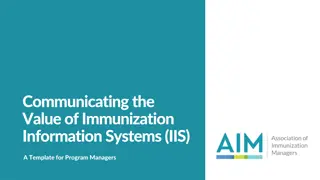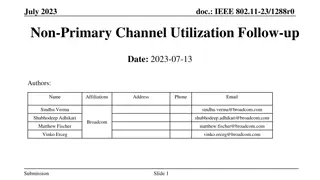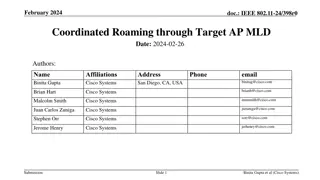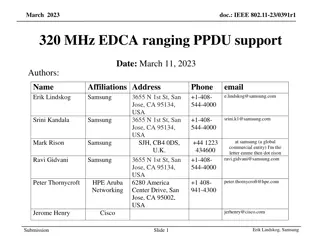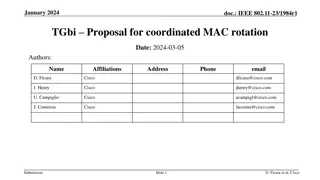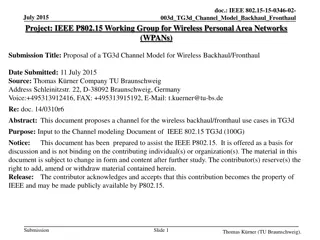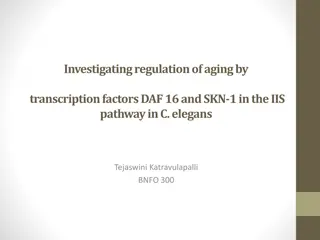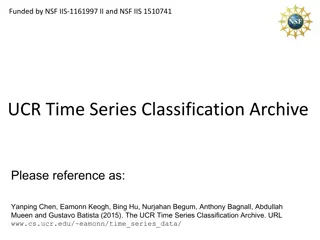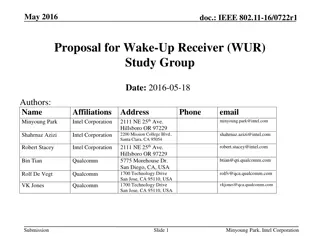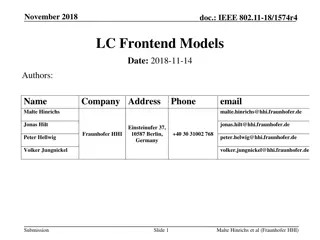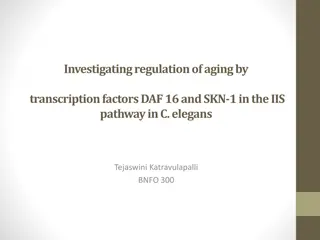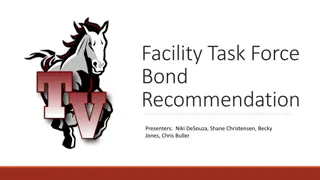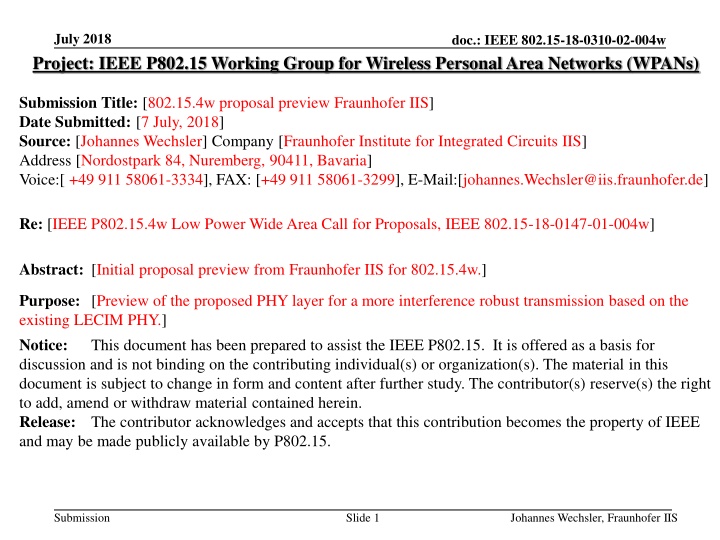
IEEE 802.15.4w Proposal by Fraunhofer IIS for Robust Wireless Transmission
"Discover Fraunhofer IIS's proposal for IEEE 802.15.4w, focusing on a robust PHY layer to enhance interference resistance. Explore motivations behind the design for smart and connected systems, LPWA networks, and challenges in dealing with increased interference."
Download Presentation

Please find below an Image/Link to download the presentation.
The content on the website is provided AS IS for your information and personal use only. It may not be sold, licensed, or shared on other websites without obtaining consent from the author. If you encounter any issues during the download, it is possible that the publisher has removed the file from their server.
You are allowed to download the files provided on this website for personal or commercial use, subject to the condition that they are used lawfully. All files are the property of their respective owners.
The content on the website is provided AS IS for your information and personal use only. It may not be sold, licensed, or shared on other websites without obtaining consent from the author.
E N D
Presentation Transcript
July 2018 Project: IEEE P802.15 Working Group for Wireless Personal Area Networks (WPANs) doc.: IEEE 802.15-18-0310-02-004w Submission Title: [802.15.4w proposal preview Fraunhofer IIS] Date Submitted: [7 July, 2018] Source: [Johannes Wechsler] Company [Fraunhofer Institute for Integrated Circuits IIS] Address [Nordostpark 84, Nuremberg, 90411, Bavaria] Voice:[ +49 911 58061-3334], FAX: [+49 911 58061-3299], E-Mail:[johannes.Wechsler@iis.fraunhofer.de] Re: [IEEE P802.15.4w Low Power Wide Area Call for Proposals, IEEE 802.15-18-0147-01-004w] Abstract: [Initial proposal preview from Fraunhofer IIS for 802.15.4w.] Purpose: [Preview of the proposed PHY layer for a more interference robust transmission based on the existing LECIM PHY.] Notice: This document has been prepared to assist the IEEE P802.15. It is offered as a basis for discussion and is not binding on the contributing individual(s) or organization(s). The material in this document is subject to change in form and content after further study. The contributor(s) reserve(s) the right to add, amend or withdraw material contained herein. Release: The contributor acknowledges and accepts that this contribution becomes the property of IEEE and may be made publicly available by P802.15. Submission Slide 1 Johannes Wechsler, Fraunhofer IIS
July 2018 doc.: IEEE 802.15-18-0310-02-004w Proposal preview for 802.15.4w Fraunhofer IIS Johannes Wechsler Fraunhofer IIS Submission Slide 2 Johannes Wechsler, Fraunhofer IIS
July 2018 doc.: IEEE 802.15-18-0310-02-004w Motivation (1) Trend: everything is smart and connected: houses, cities, meters, headphones more and more wirelessly connected devices Most networks operate within a very limited range and don t require very high sensitivity Only very close networks interfere one another Submission Slide 3 Johannes Wechsler, Fraunhofer IIS
July 2018 doc.: IEEE 802.15-18-0310-02-004w Motivation (2) Low Power Wide Area (LPWA) networks for smart metering, predictive maintenance etc., use very high sensitivity to achieve low-power and wide-area (10km+) Many networks are potential interferers for the LPWA network LPWA Submission Slide 4 Johannes Wechsler, Fraunhofer IIS
July 2018 doc.: IEEE 802.15-18-0310-02-004w Motivation (3) Radio systems originally designed for reliable long range communication have to deal with increased interference, especially in narrow, unlicensed bands [4] 22 interferer linear frequency sweep 20 18 16 frequency channel wide-band interferer 14 12 wide band spread- spectrum interferer 10 8 narrow-band interferer 6 4 2 0 3.5 0 0.5 1 1.5 2 2.5 3 time [sec] Submission Slide 5 Johannes Wechsler, Fraunhofer IIS
July 2018 doc.: IEEE 802.15-18-0310-02-004w Goals for 802.15.4w Extend 802.15.4 portfolio with option for LPWA at high interference [2] 802.15.4 for Low energy critical infrastructure monitoring (LECIM) FSK perfect candidate for extension to LPWA applications [4][1] Already uses fragmentation Designed for low data rates Already includes FEC and interleaving Extend 802.15.4 LECIM FSK [3][4] Improve interference resilience with codeword fragmentation Extend to lower data rates to be even better suited for LPWA applications Submission Slide 6 Johannes Wechsler, Fraunhofer IIS
July 2018 doc.: IEEE 802.15-18-0310-02-004w Time Split Multiple Access (TSMA) Improve interference resilience with codeword fragmentation spread fragments (sub-packets) over time AND spread sub-packets over frequency (similar to FHSS) capitalize on time and on frequency diversity Many sub-packets (green) are not affected by interference 22 20 18 16 frequency channel 14 12 FEC can compensate losses 10 8 6 4 Low packet error rate (PER) despite interference 2 0 3.5 0 0.5 1 1.5 2 2.5 3 time [sec] Submission Slide 7 Johannes Wechsler, Fraunhofer IIS
July 2018 doc.: IEEE 802.15-18-0310-02-004w Detectability / Synchronization Decodeability in interference channels given through FEC Detectability in interference channels through inclusion of synchronization header (SHR) in every sub-packet Distributed SHR allow detection and synchronization even if multiple sub-packets are interfered Variable Data-Length SHR Submission Slide 8 Johannes Wechsler, Fraunhofer IIS
July 2018 doc.: IEEE 802.15-18-0310-02-004w Synchronization header (SHR) SHR design considerations for TSMA Non-TSMA overhead only one SHR TSMA multiple SHR Reduce size for single SHR to reduce overhead Allow reception with current off-the-shelf transceiver ICs SHR as short prefix with start-of-frame delimiter SFD and short preamble SFD and preamble combined to form 16 bit header 16 bit widely supported by current transceivers Additional preamble octets 01010101 configurable Configurable Preamble Bits: 0 3 4-15 0101 SFD Submission Slide 9 Johannes Wechsler, Fraunhofer IIS
July 2018 doc.: IEEE 802.15-18-0310-02-004w Sub-packet splitting Fragmentation of coded words and distribution over time Time-Split Multiple Access A single transmission comprises a fixed number of sub-packets here called a block Number of sub-packets in a block depends on FEC Sub-packet length depends on payload length sub-packet Block Submission Slide 10 Johannes Wechsler, Fraunhofer IIS
July 2018 doc.: IEEE 802.15-18-0310-02-004w Blocks PHY service data unit (PSDU) A block can transmit up to 32 bytes PSDU PSDU size limited to 32byte for TSMA mode Memory requirements increase with the lengths of the PSDUs LPWAN applications predominantly use small payloads Optimized for these small payloads PSDUs exceeding 32 byte are fragmented in higher layers Possibly work in existing LECIM Fragmentation (?) Submission Slide 11 Johannes Wechsler, Fraunhofer IIS
July 2018 doc.: IEEE 802.15-18-0310-02-004w PHY Header (PHR) No changes necessary to existing header [1] Bits: 0 1 Reserved 2 3 4 5 15 Parity FCS Type Data Whitening Frame Length Considerations for possible enhancements Frame Length length cannot exceed 32 (5bit would suffice for this proposal) Zero tailing for FEC is used 6 bits of 0 are always added, leaving two bits to a full byte Payloads are always multiple of byte Use 2 additional reserved bits to make MUX of PHR and PSDU a fully filled byte array without leftover bits Submission Slide 12 Johannes Wechsler, Fraunhofer IIS
July 2018 doc.: IEEE 802.15-18-0310-02-004w TSMA Symbol rates and channel spacing SDR receivers are capable to receive multiple transmissions simultaneously Detection very computationally expensive when a plethora of options for modulation, data rate and channelization need to be considered Efficient FFT based implementation possible, when: Channel spacing is an integer multiple of the symbol rate (G)MSK modulation ideal candidate width of 1bit/s/Hz allows channel widths of symbol rate in hz Submission Slide 13 Johannes Wechsler, Fraunhofer IIS
July 2018 doc.: IEEE 802.15-18-0310-02-004w Modulation LECIM offers multiple choices for FSK [1] already includes a modulation index of 0.5 MSK Add Gaussian filtering with a BT of 1.0 Further narrow down spectral mask Increase spectral efficiency to reduce impact on existing systems Most common transceivers already support GFSK modulation Submission Slide 14 Johannes Wechsler, Fraunhofer IIS
July 2018 doc.: IEEE 802.15-18-0310-02-004w Symbol rate (1) Lowest symbol rate ?????= 2380.37109375??????? Very specific number to establish good hardware support and interoperability for narrow-band communication Narrowband communication goes to the lower limit of hardware transceivers Absolute errors in freq. resolution result in significant higher relative errors at lower bandwidths and symbol rates ? freq. res narrow band signal wide band signal Submission Slide 15 Johannes Wechsler, Fraunhofer IIS
July 2018 doc.: IEEE 802.15-18-0310-02-004w Symbol rate (2) Common freq. resolution for transceivers ~100 Hz @900 MHz band Worst case channel error = 50 Hz Relative error at mismatch @ 2kHz channels: 2.5% error by design if step sizes mismatch Deviation resolution and channel resolution commonly identical or separated by an integer multiple MSK through FSK modulator by deviation 1/4th of symbol rate If deviation can t be matched, modulation error by design Submission Slide 16 Johannes Wechsler, Fraunhofer IIS
July 2018 doc.: IEEE 802.15-18-0310-02-004w Symbol rate (3) Goal: Good support for current off-the shelf crystals and oscillators Most transceivers use a power-2 decimator in the fractional PLL Freq. resolution = (Crystal Frequency) / 2^x with x commonly between 16 and 20 for channelization and between 16 and 22 for deviation Transceivers often utilize crystals that are widely available 26 MHz (GSM) 32 MHz (Used in many transceivers) 38.4 MHz (USB) Submission Slide 17 Johannes Wechsler, Fraunhofer IIS
July 2018 doc.: IEEE 802.15-18-0310-02-004w Symbol rate (4) Symbol rate ideally is a multiple that can be obtained using one of these crystal frequencies divided by a power-of-2 and multiplied by an integer For ?????= 2380.37109375??????? ? Crystal frequency min. Power-of-2 for channelization For deviation 26 MHz 32 MHz 38.4 MHz 39 MHz 16 19 20 14 18 21 22 16 Submission Slide 18 Johannes Wechsler, Fraunhofer IIS
July 2018 doc.: IEEE 802.15-18-0310-02-004w Symbol rate (5) Higher data rates by increasing the symbol rate in power of 2 multiples of ????? Maintain good XTAL support Lower data rates by using LECIM spreading Maintain good XTAL support Lower symbol rates would complicate synchronization even more Modulation envelope stays as wide as lowest data rate Submission Slide 19 Johannes Wechsler, Fraunhofer IIS
July 2018 doc.: IEEE 802.15-18-0310-02-004w Forward Error Correction (FEC) Forward Error Correction Use existing Rate 1/2 convolutional code (LECIM) Polynomial: existing in LECIM Zero-Tailed Extend to rate 1/3 [2] Polynomial: tbd. Increase number of sub-packets per block according to coding For R = 1/2 use 12 sub-packets per block For R = 1/3 use 18 sub-packets per block Submission Slide 20 Johannes Wechsler, Fraunhofer IIS
July 2018 doc.: IEEE 802.15-18-0310-02-004w Interleaving Block erasure or block interference are most common scenario in radio channels LECIM interleaver already deals with block errors TSMA adds time-frequency distribution extend interleaver to sub-packets 22 20 Needs to handle loss or distortion of: single sub-packet (most common) multiple successive sub-packets (seldom) 18 frequency channel 16 14 12 10 8 6 4 2 0 3.5 0 0.5 1 1.5 time [sec] 2 2.5 3 Submission Slide 21 Johannes Wechsler, Fraunhofer IIS
July 2018 doc.: IEEE 802.15-18-0310-02-004w Interleaving by example (1) No Interleaving code word 0 1 2 3 4 5 6 7 8 9 10 11 12 13 ... ... 0 1 2 3 4 10 11 12 13 14 sub-packet 0 sub-packet 2 15 16 17 18 19 sub-packet 3 5 6 7 8 9 sub-packet 1 received code word 0 1 2 3 4 5 6 7 8 9 10 11 12 13 14 ... Loss of 1st Loss of 1st and 2nd received code word 0 1 2 3 4 5 6 7 8 9 10 11 12 13 14 ... Submission Slide 22 Johannes Wechsler, Fraunhofer IIS
July 2018 doc.: IEEE 802.15-18-0310-02-004w Interleaving by example (2) Spread consecutive symbols of codeword in different sub- packets code word 0 1 2 3 4 5 6 7 8 9 10 11 12 13 ... 0 4 8 12 16 2 6 10 14 18 sub-packet 0 sub-packet 2 3 7 11 15 19 sub-packet 3 1 5 9 13 17 sub-packet 1 received code word Loss of 1st Loss of 1st and 2nd 0 1 2 3 4 5 6 7 8 9 10 11 12 13 14 ... received code word 0 1 2 3 4 5 6 7 8 9 10 11 12 13 14 ... Submission Slide 23 Johannes Wechsler, Fraunhofer IIS
July 2018 doc.: IEEE 802.15-18-0310-02-004w Interleaving by example (3) spread the sub-packets originally filled with consecutive symbols as far apart as possible 0 4 8 12 16 2 6 10 14 18 sub-packet 0 sub-packet 2 3 7 11 15 19 switch sub-packet 3 1 5 9 13 17 sub-packet 1 received code word Loss of 1st Loss of 1st and 2nd 0 1 2 3 4 5 6 7 8 9 10 11 12 13 14 ... received code word 0 1 2 3 4 5 6 7 8 9 10 11 12 13 14 ... Submission Slide 24 Johannes Wechsler, Fraunhofer IIS
July 2018 doc.: IEEE 802.15-18-0310-02-004w Interleaving Method 1. Order the first input symbols linear to the S sub-packets 1. First symbol first sub-packet, 2. Second symbol second sub-packet, 3. S-th symbol S-th sub-packet, 4. S+1 th symbol first sub-packet, 5. Repeat until all symbols are mapped to sub-packets Reorder sub-packets to further improve distance for long-wide band interferers first symbol first symbol first symbol second symbol 2. 3. Submission Slide 25 Johannes Wechsler, Fraunhofer IIS
July 2018 doc.: IEEE 802.15-18-0310-02-004w Symbols and data rate overview Total PHY payload size 32 8 + 16 = 272 bits of uncoded data Required symbols Rate 1/3: 272 * 3 + 6 * 3 = 834 Rate 1/2: 272 * 2 + 6 * 2 = 556 Data symbols per sub-packet 834 / 18 = 576 / 12 = 46.3333 47 SHR adds additional 16 symbols Sub-packet size: maximum 63 symbols Submission Slide 26 Johannes Wechsler, Fraunhofer IIS
July 2018 doc.: IEEE 802.15-18-0310-02-004w Time/Frequency Pattern (1) Design goals Optimize to cope well with expected interference [4] Minimal time gap needs to be longer than longest interferer Minimal frequency step should exceed bandwidth of widest interferer Minimize impact on existing 802.11/15 networks Comply with regulatory requirements to be considered a FHSS system in EU (EN 300 220) and NA (FCC 15.247) At least 57 channels (EU) At least 25 kHz wide (NA) Use all channels with same duty cycle (NA) Submission Slide 27 Johannes Wechsler, Fraunhofer IIS
July 2018 doc.: IEEE 802.15-18-0310-02-004w Time/Frequency Pattern (2) Channelization 72 Channels Channel spacing 12 * ????? = 28564 Hz Hopping Sequences Blocks need to occupy all 72 channels evenly Single pattern for block will occupy 12 or 18 channels 12-pattern is used freq. shifted 6 times to cover all 72 channels 18-pattern is used freq. shifted 4 times to cover all 72 channels Channels within pattern should be spaced 6 or 4 channels apart respectively Frequency shifted patterns are shifted by 1 channel Number of patterns, final design and usage of different patterns require more 802.15 expertise! Submission Slide 28 Johannes Wechsler, Fraunhofer IIS
July 2018 doc.: IEEE 802.15-18-0310-02-004w Proposed LECIM FSK Reference Modulator PHR PSDU No Changes Minor Adjustments MUX New Blocks FEC Interleaver Data Whitening Sub-packet splitting MUX SHR generation Sub-packet demux/timer FSK Modulation Bit-to-symbol mapping Modulated signal Submission Slide 29 Johannes Wechsler, Fraunhofer IIS
July 2018 doc.: IEEE 802.15-18-0310-02-004w Simulation models and settings Setup environment from [3] Noise figure = 3 dB Channel models TU0: Typical Urban 0Hz Doppler [4] TU3: Typical Urban 3Hz Doppler [4] Interference models to test against [3] Outdoor urban, hBS=140m [4] Submission Slide 30 Johannes Wechsler, Fraunhofer IIS
July 2018 doc.: IEEE 802.15-18-0310-02-004w Simulation Parameters Additional settings 10.000 packets per point to achieve smooth graphs Maximum PSDU size of 32 Bytes PSDU 64 Symbols per sub-packet 64 Symbols gap between sub-packets TSMA Time gap 64 symbols to cope with longest interferers of given model 2.0 MHz bandwidth Receiver decodes with realistic channel estimation FEC = 1/3 rate convolutional code Effective data rates include FEC, PHR and SHR Symbol rate (kS/s) Eff. data rate (kbit/s) 2.38 + 2*Spread 2.38 0.58 4.76 1.17 19.04 4.66 0.29 Submission Slide 31 Johannes Wechsler, Fraunhofer IIS
July 2018 doc.: IEEE 802.15-18-0310-02-004w Minimum Required Sensitivity Effective data rate of 0.29 kBit/s achieves required - 140 dBm easily at 1% PER Requires symbol spreading with factor of 2 and usage of R = 1/3 FEC Submission Slide 32 Johannes Wechsler, Fraunhofer IIS
July 2018 doc.: IEEE 802.15-18-0310-02-004w Impact of TSMA with FEC (1) Comparison based on same on-air time to have same energy requirement for transmission FEC 1/3 coded TSMA Effective data rate ~4.66 kbit/s Total on-air time 60ms Uncoded 35.25 Byte = 282 bits @ 4.76 kbit/s Total on-air time 59ms Submission Slide 33 Johannes Wechsler, Fraunhofer IIS
July 2018 doc.: IEEE 802.15-18-0310-02-004w Impact of TSMA with FEC (2) no interference transmission at same transmission energy 15 dB gain of proposal compared to uncoded at 1% PER 15 dB Submission Slide 34 Johannes Wechsler, Fraunhofer IIS
July 2018 doc.: IEEE 802.15-18-0310-02-004w Impact of TSMA with FEC (3) interference outdoor urban, h = 140m [4] transmission at same transmission energy 28 dB+ gain of proposal compared to uncoded at 1% PER 28.5 dB Submission Slide 35 Johannes Wechsler, Fraunhofer IIS
July 2018 doc.: IEEE 802.15-18-0310-02-004w Impact of TSMA with FEC (4) Same on-air time for both transmissions for approximately similar power consumption FEC coded can achieve same performance at ~ 1/500th of the required transmit energy 28 dB difference in required energy correspond to roughly to the comparison of a coin cell battery with a milk carton with same energy density vs Submission Slide 36 Johannes Wechsler, Fraunhofer IIS
July 2018 doc.: IEEE 802.15-18-0310-02-004w Interference Robustness (1) Scenario less exposed receiver rural, h = 32m 5 dB gain over FEC coded transmission without TSMA at 1% PER only 1.5 dB loss compared to non- interfered transmission at 1% PER 5 dB Submission Slide 37 Johannes Wechsler, Fraunhofer IIS
July 2018 doc.: IEEE 802.15-18-0310-02-004w Interference Robustness (2) Required Scenario urban, h = 140m [4] 8.5 dB gain over FEC coded transmission without TSMA at 1% PER only 3 dB loss compared to non- interfered transmission at 1% PER 8.5 dB Submission Slide 38 Johannes Wechsler, Fraunhofer IIS
July 2018 doc.: IEEE 802.15-18-0310-02-004w Topics discussed in this preview Data Rate Symbol/Chip rates Forward Error Correction Modulation/Coding Fragmentation PHY Frame Structure Transmit PSD Operational Bands Minimum Required Sensitivity Interference Robustness Submission Slide 39 Johannes Wechsler, Fraunhofer IIS
July 2018 doc.: IEEE 802.15-18-0310-02-004w Open topics Simulations to be done Coexistence Features Multipath Robustness Discussion and feedback from the group required Time-/ Frequency Patterns Frequency, Synchronization and Timing (accuracies) Discussion and feedback from the group on all topics presented here is very much appreciated Submission Slide 40 Johannes Wechsler, Fraunhofer IIS
July 2018 doc.: IEEE 802.15-18-0310-02-004w Thank you! Any questions or suggestions? Submission Slide 41 Johannes Wechsler, Fraunhofer IIS
July 2018 doc.: IEEE 802.15-18-0310-02-004w References [1] IEEE Std 802.15.4 [2] P802.15.4w PAR [3] 802.15.4w Technical Guidance Document; 12 March, 2018; 15- 18-0161-00-004w [4] Draft IG LPWA Report; 3 November, 2017; 15-17-0528-01 -2015 Submission Slide 42 Johannes Wechsler, Fraunhofer IIS

